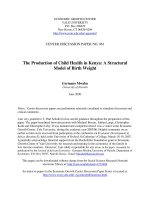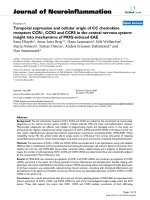Phase transition in the linear sigma model of the two-component mixing system
Bạn đang xem bản rút gọn của tài liệu. Xem và tải ngay bản đầy đủ của tài liệu tại đây (446.14 KB, 8 trang )
HNUE JOURNAL OF SCIENCE
DOI: 10.18173/2354-1059.2019-0028
Natural Science, 2019, Volume 64, Issue 6, pp. 31-38
This paper is available online at
PHASE TRANSITION IN THE LINEAR SIGMA MODEL
OF THE TWO-COMPONENT MIXING SYSTEM
Le Viet Hoa1, Nguyen Tuan Anh2, Dang Thi Minh Hue3
and Dinh Thanh Tam4
1
Faculty of Physics, Hanoi National University of Education
2
Faculty of Energy Technology, Electric Power University
3
Faculty of Energy, Water Resources University
4
Faculty of Mathematics-Physics-Informatics, University of Tay Bac
Abstract. The thermal and quantum phase transitions are studied basing on the
Cornwall-Jackiw-Tomboulis (CJT) effective action approach for the relativistic
linear sigma model of the two-component mixing system. After obtaining the
expression of the thermodynamic potential in Hartree-Fock (HF) approximation,
which preserves the Goldstone theorem, the numerical results show that there may
be two phase transition scenarios in the system. The first scenario is the thermal
phase transition which can only occur in one component. The second scenario is
quantum phase transitions which can occur in both two components. In addition,
both these two types of phase transitions belong the second order phase transition.
Keywords: Two-component system, CJT effective action, Hartree-Fock (HF)
approximation, Goldstone theorem, thermal phase transition, quantum
phase transition.
1.
Introduction
The phenomenon of kaon condensation has been extensively investigated since
Kaplan and Nelson [1] showed that kaon condensation could occur at a density around
3ρ0 , where ρ0 is the normal nuclear density. No long time after, it was proved [2] that
kaons are condensed in quark matter at sufficiently high densities and low temperature is
in the color-flavor-locked (CFL) phase, and their dynamics [3] is essentially described
by the linear sigma model at finite density, which is not invariant under the Lorentz
transformations.
In recent years many works (for example, [4-11], and others) related to phase
transition, symmetry breaking and restoration, Bose-Einstein condensation, etc. have
Received April 19, 2019. Revised June 21, 2019. Accepted June 28, 2019.
Contact Le Viet Hoa, e-mail address:
31
Le Viet Hoa, Nguyen Tuan Anh, Dang Thi Minh Hue and Dinh Thanh Tam
been implemented within the linear sigma model because this model is considered to
be best suited for the theory of low energy phenomena of quantum chromodynamic
(QCD). In the present work the linear sigma model at finite density and temperature
is reconsidered by means of the Cornwall-Jackiw-Tomboulis (CJT) effective action.
However, there is a serious difficulty related to re-standardizing the effective action to
satisfy Goldstone theorem in the Hartree-Fock (HF) approximation. In order that the
Goldstone theorem is respected and the renormalization is achieved in this approximation
we adopt the gapless resummation and the renormalization prescription developed in
[6, 7], respectively.
In addition, the previous models are mainly limited to one field of multiple
components or two fields in the non-relativistic case. Therefore, expanding the model for
describing the two-component mixing system in the relativistic case is essential because it
allows to clarify many effects related to the internal structure of the stars such as neutron
stars [12, 13], or the existence of quark matter in the color-flavor-locked phase at high
density and low temperature [14]. This paper presents the research results initially in
that direction.
2.
Content
2.1. Lagrangian of the model and the CJT effective potential
Let us start from the linear sigma model of the two-component mixing system
described by the lagrangian [11]:
L = (∂ 0 φ∗ )(∂0 φ) − (∂ a φ∗ )(∂a φ) − iµ1 [(∂ 0 φ∗ )φ − φ∗ (∂0 φ)] + (µ21 − m21 )(φ∗ φ)
+(∂ 0 ψ ∗ )(∂0 ψ) − (∂ a ψ ∗ )(∂a ψ) − iµ2 [(∂ 0 ψ ∗ )ψ − ψ ∗ (∂0 ψ)] + (µ22 − m22 )(ψ ∗ ψ)
−λ1 (φ∗ φ)2 − λ2 (ψ ∗ ψ 2 − λ(φ∗ φ)(ψ ∗ ψ).
(2.1)
Here m1 , µ1 (m2 , µ2 ) are, respectively, mass and chemical potential of the complex
doublet field φ (ψ); λ1 , λ2 , λ are coupling constants and ∂a = ∂x∂ a , ∂0 = ∂x∂ 0 .
This model gives the CJT effective potential VβCJT (φ0 , ψ0 , D, G) at finite
temperature in the HF approximation, which preserves the Goldstone theorem
CJT
Vβ
+
T
2
n
(φ0 , ψ0 , D, G) = (−µ21 + m21 )φ20 + (−µ22 + m22 )ψ02 + λ1 φ40 + λ2 ψ04 + λφ20 ψ02
d3 k
tr ln D −1 (k) + ln G−1 (k) + D0−1 (k; φ0, ψ0 )D + G−1
0 (k; φ0 , ψ0 )G − 211
(2π)3
λ1 2
λ1 2
3λ1
P11 + P22
+
P11 P22 +
4
4
2
λ
λ
+ P11 Q11 + P11 Q22 +
4
4
including the gap and SD equations:
+
32
λ2 2
λ2
3λ2
Q11 + Q222 +
Q11 Q22
4
4
2
λ
λ
P22 Q11 + P22 Q22 ,
4
4
(2.2)
Phase transition in the linear sigma model of the two-component mixing system
* The gap equations
λ
λ
−µ21 + m21 + 2λ1 φ20 + λψ02 + 3λ1 P11 + λ1 P22 + Q11 + Q22 = 0,
2
2
λ
λ
−µ22 + m22 + λφ20 + 2λ2 ψ02 + P11 + P22 + 3λ2 Q11 + λ2 Q22 = 0,
2
2
(2.3)
*The SD equations
λ
λ
M12 = −µ21 + m21 + 6λ1 φ20 + λψ02 + λ1 P11 + 3λ1 P22 + Q11 + Q22 ,
2
2
λ
λ
M22 = −µ22 + m22 + λφ20 + 6λ2 ψ02 + P11 + P22 + λ2 Q11 + 3λ2 Q22 .
2
2
(2.4)
Here D, G are the complete propagators, T = 1/β is the temperature and P and Q
are the notations
Paa = T
n
Qaa = T
n
d3 k
Daa (ωn , k) ; a = 1, 2,
(2π)3
d3 k
Gaa (ωn , k) ; a = 1, 2.
(2π)3
(2.5)
2.2. Numerical calculation
In this section we perform numerical calculations to study the phase transition in
the linear sigma model of the two-component mixing system in accordance with the two
processes when the temperature and / or the chemical potential change. These are two
typical physical processes corresponding to thermal phase transition and quantum phase
transition. To do this, first need to select the parameters for the model. Basing on [16]
we choose masses and chemical potentials correspond to kaons, namely m1 = 5 MeV,
m2 = 4 MeV, µ1 = 4.5 MeV, and the coupling constants selected are λ1 = 0.0048, λ2 =
0.005, λ = 0.004. Next, we need to determine the phase structure of the system by
drawing phase balance curves. By numerical solving equations (2.4) and (2.3) we draw
lines φ0 = 0, ψ0 = 0 in the phase plane T − µ2 and obtain result as shown in Figure 1.
As can be seen in Figure 1, with µ2c1 ≃ 2 MeV < µ2 < µ2c2 ≃ 3.8 MeV there is
a desert corresponding to both φ0 = 0 and ψ0 = 0. Therefore with a fixed value of µ2 ,
only φ0 = 0 or ψ0 = 0 can exist and as a result only the thermal phase transition in the
sector φ or ψ occurs. In contrast, with one a definite value of temperature T , there may
exist both φ0 = 0 and ψ0 = 0 at different values of µ2 and therefore the quantum phase
transition not only in the sector φ but also in ψ occurs. In order to get some insight the
above statements, let us examine each type of phase transition in detail.
33
Le Viet Hoa, Nguyen Tuan Anh, Dang Thi Minh Hue and Dinh Thanh Tam
Figure 1. Phase diagram in the plane T − µ2 at λ = 0.004
2.2.1. Thermal phase transition
In order to investigate thermal phase transition in the ψ sector, we choose chemical
potential µ2 = 5.5 MeV basing on Figure 1. By numerical solving the equations (2.4)
and (2.3) with the selected parameters we obtain the temperature T dependence of the ψ0
and φ0 as shown in Figure 2. Obviously, ψ0 increases steadily to zero when temperature
increases to Tcψ . That is a sign of second order phase transition.
Figure 2. The T dependence of φ0 and ψ0 at µ2 = 5.5MeV
34
Phase transition in the linear sigma model of the two-component mixing system
represents the ψ0 dependence of the effective potential
Local minimum (at ψ0 =0) of the effective potential gradually
V
shifts to the origin and completely disappears at Tcψ ≃ 120 MeV. That confirms a second
order phase transition in the ψ sector occurs at Tcψ ≃ 120 MeV.
Figure
3
CJT
(φ0 , ψ0 , D, G).
β
CJT
Figure 3. The ψ0 dependence of V β
(φ0 , ψ0 , D, G.) at several temperature
Figure 4. The T dependence of φ0 and ψ0
35
Le Viet Hoa, Nguyen Tuan Anh, Dang Thi Minh Hue and Dinh Thanh Tam
Analogously, in order to investigate thermal phase transition in the φ sector, we
choose chemical potential µ2 = 1.5 MeV. Figure 4 represents the temperature dependence
of the vacuum expectation values ψ0 , φ0 . As is seen from this figure the phase transition
in the sector φ also is second order and takes place at temperature Tcφ ≃ 27.5 MeV.
2.2.2. Quantum phase transition
Quantum phase transition is a phase transition that occurs at a fixed temperature
when the chemical potential changes. Figure 5 shows the µ2 dependence of φ0 and
ψ0 at T = 10 MeV. As can be seen on this figure, when the chemical potential µ2
increases, the φ0 decreases to zero and then is replaced by the ψ0 . With µ2c1 ≃ 2 MeV
< µ2 < µ2c2 ≃ 3.8 MeV both φ0 and ψ0 cannot coexist. This result is completely
consistent with the comment that was taken from Figure 1. Moreover, the monotonous
variation of φ0 and ψ0 also shows signs of second order phase transition. This is
also clearly shown in Figure 6 drawing the dependence ψ0 of the effective potential
CJT
V β (φ0 , ψ0 , D, G) at several values of µ2 : When µ2 increases over the value µ2c2 , the
CJT
minimum of V β (φ0 , ψ0 , D, G) gradually moves out of the origin (corresponding to
ψ0 = 0). This means that the system from symmetrical phase to other symmetrical phase
is broken at µ2c2 .
Figure 5. The µ2 dependence of φ0 and ψ0 at T = 10MeV
36
Phase transition in the linear sigma model of the two-component mixing system
Figure 6. The ψ0 dependence of φ0 , ψ0 at several values of the chemical potential µ2
3.
Conclusion
In this paper the phase transitions in the linear sigma model were considered by
means of the finite temperature CJT effective action. The main results are following:
1-The thermodynamic potential of system in the HF approximation, which is
renormalized and respects Goldstone theorem.
2-There may be two phase transition scenarios in the system. The first scenario is
the thermal phase transition which can only occur in one component. The second scenario
is quantum phase transitions which can occur in both two components depending on the
effect of temperature or chemical potential. These results are confirmed by EoS.
3-Both the thermal and quantum phase transitions belong to the second order.
Actually, in order to highlight physical properties of kaon matter we proceed to
the numerical computation of phase transition patterns taking a set of kaon masses and
chemical potential specified in [7], while the coupling constants are chosen from T − µ
phase diagram Figure 1 to get desired scenarios. To conclude, we would like to emphasize
that the formalism developed in this paper is also useful for all studies of nuclear and
particle dynamics at finite density and temperature starting from the linear sigma model
at different energy scales. At scale of order 10 MeV we deal with nuclear structure if
the degrees of freedom are sigma, pions, and nucleons. For higher energy of order 100
MeV we are led to the chiral dynamics of hadrons with nucleons replaced by quarks and
at scale of order 100 GeV the Higgs physics of the electroweak theory emerges. This is
evidently the promising task for the next research.
Acknowledgment. This work is funded by the Vietnam Foundation of Education and
Training Ministry.
37
Le Viet Hoa, Nguyen Tuan Anh, Dang Thi Minh Hue and Dinh Thanh Tam
REFERENCES
[1]
[2]
[3]
[4]
[5]
[6]
[7]
[8]
[9]
[10]
[11]
[12]
[13]
[14]
[15]
[16]
38
D. B. Kaplan and A. E. Nelson, 1986. Phys. Lett. B175, 57.
M. G. Alford, K. Rajagopal and F. Wilczek, 1999. Nucl. Phys. B537, 443.
P. F. Bedaque and T. Schaefer, 2002. Nucl. Phys. A697, 802.
G. Amelino-Camelia, 1997. Phys. Lett. B407, 268, hepph/ 9702403.
J.T. Lenaghan and D.H. Rischke, 2000. J. Phys. G26, 431, nucl-th/9901049.
Tran Huu Phat, Nguyen Tuan Anh and Le viet Hoa, 2004. Eur. Phys. J. A19(3), 359.
Tran Huu Phat, Le viet Hoa, Nguyen Tuan Anh and Nguyen Van Long, 2007. Phys.
Rev. D76, 125027.
Tran Huu Phat, Nguyen Van Long, Nguyen Tuan Anh and Le viet Hoa, 2008, Phys.
Rev. D78, 105016.
Tran Huu Phat, Le viet Hoa, Nguyen Tuan Anh and Nguyen Van Long, 2009. Ann.
Phys. 324, 2074.
Tran Huu Phat, Nguyen Tuan Anh, Le Viet Hoa and Dang Thi Minh Hue, Int. 2016.
J. Mod. Phys. B30(26), 1650195.
Le Viet Hoa, Nguyen Tuan Anh, Dang Thi Minh Hue and Dinh Thanh Tam, 2019.
HNUE J. Sci. Vol. 64, Issue 3, pp. 36-44.
M. Prakash, I. Bombaci, P. I. Ellis, J. M. Lattimer and R. Knorren, 1997. Phys. Rep.
280, 1 and references herein.
J. A. Pons, S. Reddy, P. J. Ellis, M. Prakash and J. M. Lattimer, 2000. Phys. Rev. C
62, 035803.
M. G. Alford, K. Rajagopal and F. Wilczek, 1999. Nucl. Phys. B 537, 443.
Yu. B. Ivanov, F. Riek and J. Knoll, 2005. Phys. Rev. D 71, 105016.
M. G. Alford, M. Braby and A. Schmitt, 2008. J. Phys. G 35, 025002, J. Phys. G 35,
115007.









